ASIAN VS CAUCASIAN EYELIDS
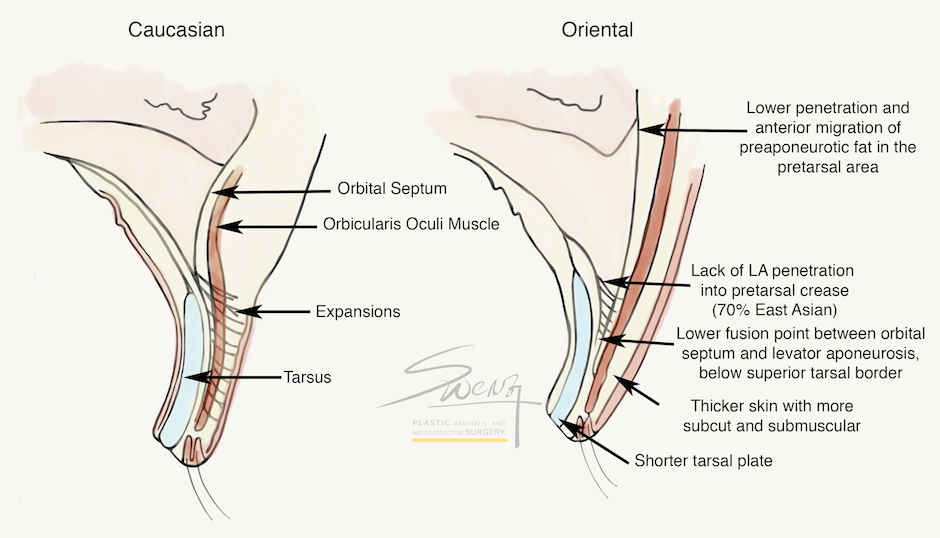
Caucasian Double Eyelid vs Oriental Single Eyelid
- The levator aponeurosis is part of the opening mechanism of the eye and which is closely related to the tarsal plate. It sends multiple slips of dermal (skin) extension which pulls on the pretarsal upper eyelids skin creating the double eyelid fold (palpebral fold).
- In many Oriental patients, the levator aponeurosis expansions (penetration) into the pre-tarsal crease are absent. This results in single eyelid appearance.
INTRODUCTION
- Upper eyelid surgery (blepharoplasty) can create or improve the configuration of double eyelid or remove excessive droopy skin. It can be done by incisional method or by suture technique.
- There are 2 methods of upper eyelid surgery:
- Purpose of incisional blepharoplasty :
- Creation of double fold :
- During incisional blepharoplasty, excess skin is removed and very fine sutures secured the wound edge (which is the location of the double fold) to the deeper eyelid structures to create a permanent fold.
- Removal of excessive upper eyelid skin (which causes the eye to appear “aged” and may obstruct vision)
- Removal of excessive upper eyelid fat pad (which gives the eyelid a puffy appearance), eyebag surgery is often done concurrently.
- Correction of ptosis (Droopy eyelid)
COMPARISON OF SUTURE AND INCISIONAL BLEPHAROPLASTY
| Suture Double Eyelid Surgery(scarless) | Incisional Double Eyelid Surgery |
|---|
| Photo | 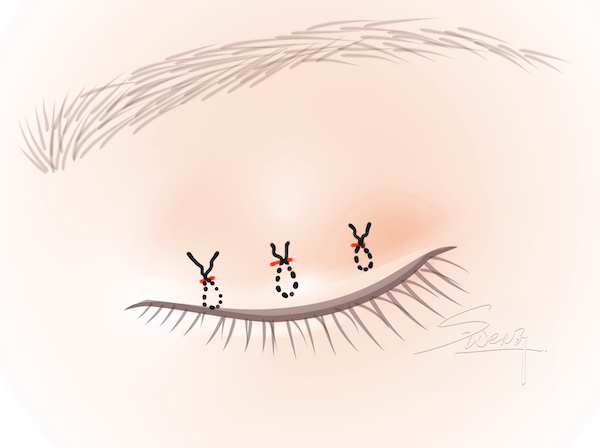 Suture Blepharoplasty  Suture blepharoplasty – Cross section | 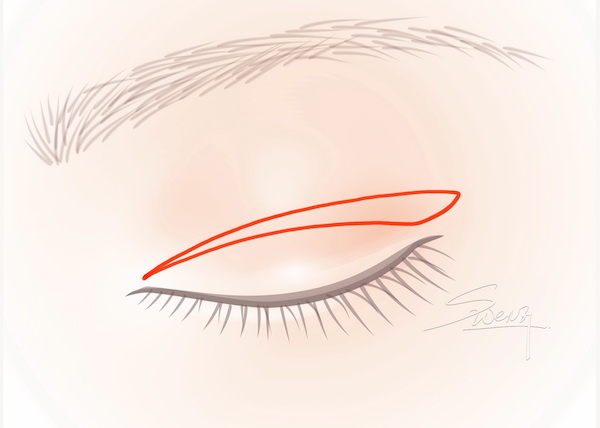 Incisional Blepharoplasty |
|---|
| Purpose |
- Creation of double eyelid fold in young patient who have no upper eyelid skin excess or fat excess.
|
- Creation of double eyelid fold (for all age groups)
- Removal of excessive upper eyelid skin
- Removal of excessive upper eyelid fat pad.
- Ptosis correction
|
|---|
| Scar | Scarless | Faint scar in the upper eyelid crease |
|---|
| Longevity of Result | Less permanent upper eyelid fold (unpredictable loss of fold) | Permanent |
|---|
| Post-surgery downtime | Generally limited swelling and bruising (however some patients has downtime similar to incisional blepharoplasty) | Swelling much improved after 1-2 weeks |
|---|
| Suture Removal | Usually none | 1 week post operative |
|---|
STYLE OF UPPER LID DOUBLE FOLD (PALPEBRAL FOLD)
| TAPERED FOLD (IN FOLD) | PARALLEL FOLD (OUT FOLD) |
|---|
 Upper Eyelid – High Tapered fold – Blepharoplasty | 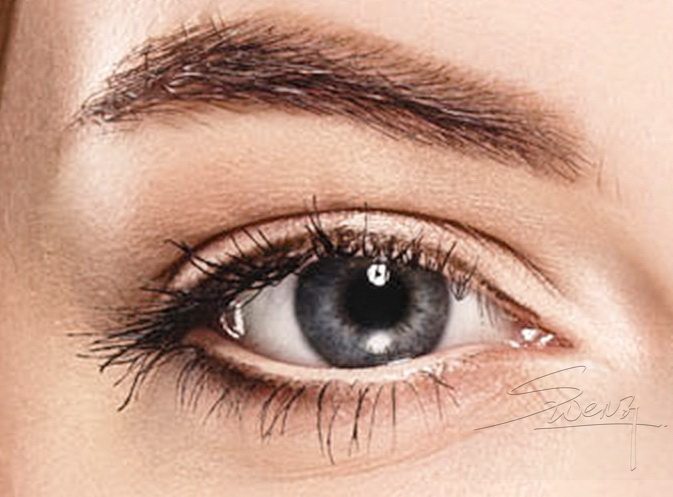 Upper eyelid – Parallel fold – Blepharoplasty |
- More common among Orientals.
- Inner corner of the double fold starts of nearer the eyelash margin and gradually tapers outwards.
|
- More common among Caucasians.
- Entire length of double fold is almost parallel to the eyelash margin.
|
| LOW FOLD | HIGH FOLD |
|---|
 Upper eyelid – Low in-fold – Blepharoplasty | 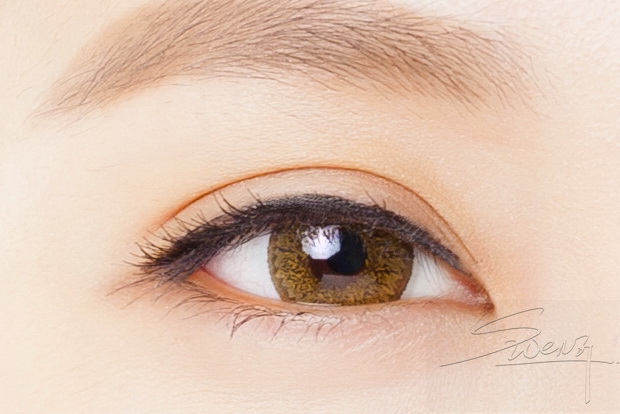 Eyelid – Tapered fold (high) |
- Narrow separation of double fold.
- Appears more natural.
- Double fold tends to disappear earlier with ageing.
|
- Wide separation of double fold.
- Appears less natural.
- Results last longer and becomes more natural with ageing
|
- The style of double eyelid fold is summarized in the table above.
- Some patients have strong tendency towards forming parallel fold. It may not be easy to create a tapered fold in this group of patients.
- During consultation Dr. Ng will advise you regarding the most suitable style and height of double eyelid fold to be created.
- In some instance the original height of the double eyelid crease can be maintained.
SUITABLE CANDIDATES
- Patient of any age group who wishes to create double upper eyelid fold.
- Patient with excessive upper eyelid causing aged appearance and/or obstructing vision
- Patient with puffy eyelids due to fat pad excess
- Patient who has weakness in the opening mechanism of the eye (Ptosis)
DESCRIPTION OF PROCEDURE
- Marking and taping simulation of the intended fold height before surgery in agreement with patient
- Incision over intended eyelid fold
- Removal of excessive upper eyelid skin, muscle and fat pads if present
- Upper eyelid crease is secured by tagging the intended fold to the deeper structures including tarsal plate.
- Meticulous wound closure with very fine non-absorbable sutures.
- Topical antibiotic ointment
- Surgical duration : about 1.5 hours
- Home on the same day
ANAESTHESIA
- Combination of local anaesthesia with IV sedation administration – for greatest comfort
POST OPERATIVE CARE
- Mild discomfort to be expected includes:
- Swelling usually resolves by 1 week.
- In rare instances swelling may take several weeks to resolve.
- Avoid exertion and rest 30 degree head up to hasten resolution of swelling.
- Bruising usually resolves by 2 weeks.
- Tearing
- Post-operative medications:
- Antibiotic ointment to be applied regularly 3-5 times a day
- Antibiotic eyedrop 3 times day
- Oral antibiotics
- Analgesics (pain relief) and anti-swelling medications
- Removal of suture at 1 week.
- Resumption of light exercise for 3-4 weeks.
- Refrain from wearing contact lens up to 4 weeks post-surgery.
RISK AND COMPLICATION
- Bleeding/ Haematoma (blood clot accumulation)
- Avoid exertion post-operative.
- Infection
- Very rare
- Avoided by clean (sterile) technique during the surgery.
FREQUENTLY ASKED QUESTION
Can we ensure symmetrical result after blepharoplasty ?
- Perfectly symmetrical eyes are uncommon.
- Many patients have pre-existing asymmetrical height of the globe of eye, size of eye-opening, the amount of extra skin and fat in the eyelids, and the distance between the brow and upper eyelid.
- Because of all these factors, asymmetry can still result despite best efforts to plan the fold symmetrically.
- Incisional blepharoplasty is more suitable to improve symmetry if you have obviously asymmetrical upper eyelids.
Can double eyelid surgery give me brighter and more alert looking eyes ?
- This depends on whether the patient has pre-existing droopy upper eyelids (blepharoptosis)
- The “bright, alert and non-sleepy” appearance of the eyes is determined by how wide the upper eyelid can open (imagine this as the “window opening”). This opening is controlled by the lifting mechanism of the upper eyelid which is in the deepest layer of the upper lids. In the usual double eyelid surgery, we operate on the superficial layers and not the deeper layer (imagine this as “trimming the curtain” only). Therefore, if the patient has pre-existing droopy upper eyelids (blepharoptosis), simple double eyelid surgery cannot restore the bright and alert appearance.
- If the patient has no pre-exiting blepharoptosis but only significant skin excess, creation or restoration of double eye fold together with removal of skin excess can potentially brighten up the eyes.
- This is the reason occasionally double eyelid consultation become prolonged due to additional explanation needed in some cases.
A consultation would guide you regarding which is the most common and best procedure used by top Singapore plastic surgeon for double eyelid surgery.
 Caucasian Double Eyelid vs Oriental Single Eyelid
Caucasian Double Eyelid vs Oriental Single Eyelid Suture Blepharoplasty
Suture Blepharoplasty Suture blepharoplasty – Cross section
Suture blepharoplasty – Cross section Incisional Blepharoplasty
Incisional Blepharoplasty Upper Eyelid – High Tapered fold – Blepharoplasty
Upper Eyelid – High Tapered fold – Blepharoplasty Upper eyelid – Parallel fold – Blepharoplasty
Upper eyelid – Parallel fold – Blepharoplasty Upper eyelid – Low in-fold – Blepharoplasty
Upper eyelid – Low in-fold – Blepharoplasty Eyelid – Tapered fold (high)
Eyelid – Tapered fold (high)